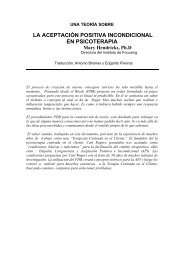8 Focusing en de experiëntiële aspecten van psychotherapie
8 Focusing en de experiëntiële aspecten van psychotherapie
8 Focusing en de experiëntiële aspecten van psychotherapie
Create successful ePaper yourself
Turn your PDF publications into a flip-book with our unique Google optimized e-Paper software.
596 Literatuur<br />
Cook, J., Schurr, P., & Foa, E. (2004). Bridging the gap betwe<strong>en</strong> PTSD research and clinical practice: The<br />
example of exposure therapy. Psychotherapy: Theory, Research, Practice and Training , 41, 374-387.<br />
Cooper, D.E. (1999). Exist<strong>en</strong>tialism. Oxford: Blackwell Publishers.<br />
Cooper, M. (2001). Embodied empathy. In S. Haugh & T. Merry (Red.), Empathy (pp. 218-229). Ross-on-<br />
Wye, UK: PCCS Books.<br />
Cooper, M. (2003a). Exist<strong>en</strong>tial therapies. London: Sage.<br />
Cooper, M. (2003b). Betwe<strong>en</strong> freedom and <strong>de</strong>spair: Exist<strong>en</strong>tial chall<strong>en</strong>ges and contributions to personc<strong>en</strong>tred<br />
and experi<strong>en</strong>tial therapy. Person-C<strong>en</strong>tered & Experi<strong>en</strong>tial Psychotherapies, 2, 43-56.<br />
Cooper, M. (2004). Towards a relationally-ori<strong>en</strong>tated approach to therapy: Empirical support and<br />
analysis. British Journal of Guidance and Counselling, 32, 451-460.<br />
Cooper, M. (2005a). The inter-experi<strong>en</strong>tial field: perceptions and metaperceptions in person-c<strong>en</strong>tered<br />
and experi<strong>en</strong>tial psychotherapy. Person-C<strong>en</strong>tered & Experi<strong>en</strong>tial Psychotherapies, 4, 54–68.<br />
Cooper, M. (2005b). Exist<strong>en</strong>tiële b<strong>en</strong>a<strong>de</strong>ring<strong>en</strong> <strong>van</strong> <strong>psychotherapie</strong> <strong>en</strong> hun relatie met <strong>de</strong> cliëntgerichte<br />
<strong>en</strong> <strong>experiëntiële</strong> psychotherapeutische b<strong>en</strong>a<strong>de</strong>ring. Tijdschrift Cliëntgerichte Psychotherapie,<br />
43, 5–29.<br />
Cooper, M. (2005c). Therapists’ experi<strong>en</strong>ces of relational <strong>de</strong>pth: A qualitative interview study. Counselling<br />
and Psychotherapy Research, 5, 87-95.<br />
Cooper, M. (Guest Ed.) (2006). Relational <strong>de</strong>pth (Special issue). Person-C<strong>en</strong>tered & Experi<strong>en</strong>tial Psychotherapy,<br />
5, Number 4, 222-292.<br />
Cooper, M., Mearns, D., Stiles, W.B., Warner, M., & Elliott, R. (2004). Developing self-pluralistic perspectives<br />
within the person-c<strong>en</strong>tered and experi<strong>en</strong>tial approaches: A round table dialogue. Person-<br />
C<strong>en</strong>tered & Experi<strong>en</strong>tial Psychotherapies 3, 176-191.<br />
Cooper, M., O’Hara, M., Schmid, P.F., & Wyatt, G. (Red.). (2007). The handbook of person-c<strong>en</strong>tred psychotherapy<br />
and counselling. Houndmills, Basingstoke: Palgrave Macmillan.<br />
Corcoran, K.J. (1981). Experi<strong>en</strong>tial empathy: A theory of felt-level experi<strong>en</strong>ce. Journal of Humanistic<br />
Psychology, 21, 29-38.<br />
Corman, L. (1973). Le test Patte Noire. Paris: PUF.<br />
Cornelius-White, J.H.D. (2007). Congru<strong>en</strong>ce as ext<strong>en</strong>sionality. Person-C<strong>en</strong>tered & Experi<strong>en</strong>tial Psychotherapies,<br />
6, 196-209.<br />
Cornway, A. (1997). Incorporating focusing in the classroom. The Folio. A Journal for <strong>Focusing</strong> and Experi<strong>en</strong>tial<br />
Therapy, 16(1-2), 35-49.<br />
Corveleyn, J., Luyt<strong>en</strong>, P, & Blatt, S.J. (2005). The theory and treatm<strong>en</strong>t of <strong>de</strong>pression. Towards a dynamic<br />
interactionism mo<strong>de</strong>l. Leuv<strong>en</strong>: Leuv<strong>en</strong> University Press.<br />
Coufal, J.D., & Brock, G.W. (1979). Par<strong>en</strong>t-Child Relationship Enhancem<strong>en</strong>t: A skills training approach.<br />
In N. Stinnett, B. Chesser, & J. DeFrain (Red.), Building family str<strong>en</strong>gths: Blueprints for action (Vol. l,<br />
pp. 233-256). London: University of Nebraska Press.<br />
Coyle, M.P. (1987). An experi<strong>en</strong>tial perspective on the mother-infant relationship: The first eight<br />
months. The <strong>Focusing</strong> Folio, 6(1), 1-28.<br />
Craeynest, P. (1997). De lev<strong>en</strong>sloop <strong>van</strong> <strong>de</strong> m<strong>en</strong>s. Inleiding in <strong>de</strong> ontwikkelingspsychologie. Leuv<strong>en</strong>: Acco.<br />
Critchfield, K.L., & B<strong>en</strong>jamin, L.S. (2006). Principles for psychosocial treatm<strong>en</strong>t of personality disor<strong>de</strong>r:<br />
Summary of the APA Division 12 task force /NASPR review. Journal of Clinical Psychology, 62, 661-<br />
674.<br />
Dantzig, A. <strong>van</strong> (1999). Is rouwbegeleiding nodig? Maandblad voor Geestelijke Gezondheid, 54, 51-55.<br />
Darwin, C. (1872). The expression of emotions in man and animals. New York: Philosophical Library.










